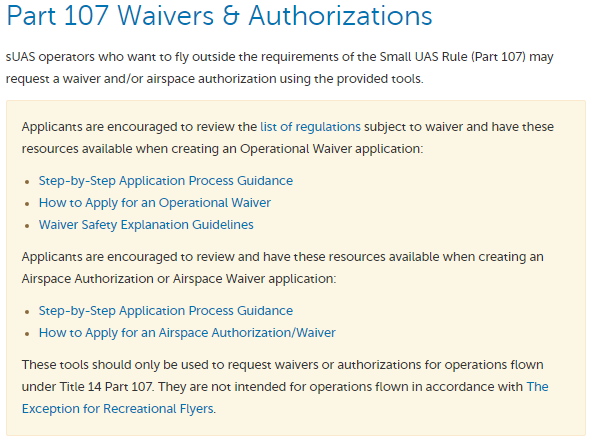In this webinar, speaker Kevin Morris provides an in depth perspective on how the FAA processes UAS related waivers. Starting with the definition taken verbatim from the slides in the video, a waiver is an official document issued by the FAA which authorizes certain operations of aircraft outside the limitations of a regulation. If you are applying for a waiver you must prove to the FAA that your mission can demonstrate an equivalent level of safety of the waived operation. If this is something that ythat interests you, click on the video below, and check out my annotations.
Although this video focuses on operational waivers, it is important to know the difference between an operational waiver and airspace authorization. Taken directly from the video slides are the following definitions.
- Operational Waiver-the authorized method in which you will operate your UAS while deviating from a regulation
- Authorization- permission to fly in a specified segment of airspace while still following all of the rules. This can be obtained through sources such as FAA Dronezone and LAANC.
 |
| Figure 1: FAA Operations that Require Waivers |
This is pretty much an outline that the FAA provides to help you write your waiver. As stated in the video, a complete description of your proposed operation must be submitted to the FAA in as much detail as possible. In addition, the FAA needs justification that demonstrates that you will fly the UAS safely while deviating the rule. Perhaps the most important words in the those two sentences are complete and justification. If you fail to communicate to the FAA how you model those words in a proposed UAS flight, your waiver will likely be rejected. If the waiver is not rejected, the FAA may prescribe further limitations on your waived operation.
Waiver Process
After determining the mission that you want to get a waiver for, Go to DroneZone and visit some of the links in the tan box similar to the screenshot shown in Figure 2. Provided that you have read the pertinent information as well as consulting other sources such as this blog, Click (on) “Create Part 107 Waiver/Authorization” and fill in the required information on the website. The FAA will then review the request and if you have provided a holistic, detailed, and data supportive evidence the FAA may give you an approved waiver in approximately 30 days. Nevertheless, the burden is on you to prove to the FAA that you will be able to the sUAS in a way that doesn't sacrifice any safety risks that are a result of the waiver in the first place.
 |
| Figure 2: FAA Dronezone Screenshot |
Waiver Tips
- Submit the waiver 90 days prior to the proposed operation to be sure that there is time
- Note the time window of your waiver
- Be sure to read all of the instructions
- Utilize the guidance links in Dronezone!
Waiver Safety Explanation Guidelines (WSEG)
This resource is mentioned in nearly every waiver related webinar so make sure you take advantage of this resource. Although it does not guarantee that following it will get your waiver approved, the (WSEG) has important questions that will be identical to the waiver itself. Furthermore it has important instructions that need to be read in their entirety to ensure that your providing the correct data the FAA requires Click here to be directed to the WSRG.
Navigating the Waiver Application: DroneZone
If you have created and loged into your DroneZone account and have followed along with the video, pay close attention to 17:00-25:00. In my opinion, there is no better way to learn about this process other than viewing it from the video. Nevertheless, there is a skeleton of this process listed below:
Know what you are requesting
- Operational Waiver? (focused on in the video)
- Airspace Authorization?
- Airspace Waiver?
- Who is the responsible party?
- Individual
- Organization
- If an organization has 10 remote pilots, that want to fly at night and a waiver is approved to do so, there is no need to submit 10 waivers.
Waiver Application
- Select Regulation that you want to be used
- Operational Parameters
- Exhibiting Waivers
- This is required for most waivers, there are some instincases where this is not required
- If you upload attachments, bookmark them so that the waiver team can process the information faster
- Dronezone Account will tell you when application is reviewed
- Make sure that waiver is 100% Complete!
- People fail to read the instructions
- People don’t filly address the Waiver Safety explanation Guidelines question
- People don’t provide a method with sufficient detail describing how risk is mitigated
Conclusion
When applying for a waiver, it is essential that you know how to navigate DroneZone and that you select the appropriate regulation that you want an exemption from. Therefore, having an understanding of general FAA regulations are essential to the success of your waiver application. In addition, you need to keep in mind that since the FAA cannot physically be present to see the operation, you must communicate your safety procedures in a way that is complete and justified. In other words, if you have an argument that your operation is safe, you not only need to provide multiple sources of data proving that, but you must validate your sources with a thorough explanation.

No comments:
Post a Comment